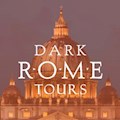There’s more to Rome than what immediately meets the eye. This is a city with plenty of sinister secrets in store if you dare to venture off the beaten track. Explore this ancient city on one of our Rome walking tours or on our Rome catacombs tour, to uncover the somber past of this iconic metropolis.
The don’t call it the Eternal City for nothing. Her history dates back a millennia. Rome’s beginnings stretch so far back, they are lost in time. And in a city this ancient, you can bet that there’s plenty of macabre and supernatural energy and occurrences to keep you on your toes.
We invite you to step into Rome’s murky past with us as we explore the City of the Dead that lurks beneath Rome’s bustling streets. Feeling brave enough? Then keep reading...
Discover the original skull and crossbones

Rome Catacombs
Rome’s catacombs can only be accessed via secret passageways and you need to know where you’re going once you get there. The alternative is spending an eternity, forever lost as you wander up and down narrow tunnels.
Our archaeological guide will meet you at Piazza Barberini, near the fountain of Triton, on our Crypts and Catacombs tour. Incidentally, this location has been chosen for a specific bone-tingling reason. From historic times until the 1800s, unidentified corpses were discarded here to rot or be identified. Whichever came first.
Once you’ve taken the time to tremble at that grisly discovery, you’ll be taken via air-conditioned coach to one of the hidden Christian catacombs dotted around the city.
The hidden status of these catacombs illustrate the sheer danger Christian martyrs faced millennia ago. During the time these catacombs were built, Christians were being sentenced to death by the authorities, the result of this persecution was that the faithful went underground.
Literally.
The catacombs in Rome, carved out of the soft volcanic rock found in Rome’s stone foundations, served as both a place of worship and a resting place for believers who had died.
Over time, as Christianity became a powerful and accepted force, Christian worship moved above ground. But the catacombs continued to play an important role in Roman life. They became a burial place for popes, especially the Catacombs of San Callisto, Catacombs of San Lorenzo and the Catacombs of San Pancrazio.
As you explore this intricate series of tunnels with us, your guide will bring to life the burial practices the early Christians followed with vivid stories. They will also point out the religious iconography, dating back thousands of years, on the low crypt ceilings and close walls.
Step up close to the ancient bones of the dead

Bone Chapel, Roman Crypts
Once we emerge from the catacombs, we hop onto the coach and travel to the Basilica of San Clemente.
Located close to the Colosseum, the foundations of the Basilica of San Clemente are reputed to date back to the Great Fire of Rome in July 64 AD. Another part of the building has connections to the cult of Mithras (a Roman mystery religion) and are still in evidence today. The “first basilica” built on this site was built in 392 AD.
Suffice to say, you’re stepping back in time when you walk into the Basilica of San Clemente. You’ll discover the perfectly preserved Roman street with its functioning aqueduct that is underneath the church. You’ll also explore the 4th century basilica that still stands here.
Then we move to the Capuchin crypts at the Church of Santa Maria della Concezioni dei Cappuccini. It’s in these crypts that you’ll be brought up close and personal with the 4,000 bones that make up the remains of the Capuchin monks and friars who are spending eternity here.
The Church of Santa Maria della Concezioni dei Cappuccini was originally commissioned to be built in 1626 by Pope Urban VIII. In 1631, the Capuchin monks arrived and brought with them two unusual items.
The first was 300 cartloads of the remains of friars who had passed away. The second was soil from Jerusalem.
The bones that make up the many haunting sculptures and decorations that you’ll see in the crypts are there to remind visitors of the fleeting nature of life. And it works. There’s something about being confronted with mortality’s spoils that reminds us of how brief life can be.
Rome’s legends and ghosts come out at night

The Statue of Giordano Bruno
The crypts and catacombs of Rome make for a truly macabre visit, but Rome still has way more grisly secrets up its sleeve.
Give yourself a scare when you join us on our Ghosts and Legends Night Walking Tour of Rome. Rome after dark is a very different place in comparison to the city we enjoy during the day...
For starters, one of the most beautiful bridges in Rome is the location of a ghostly carriage that races across its streets. Numerous eyewitness accounts attest to this frequent phantom experience. Rumor has it that the carriage carries the spooky presence of the controversial female pope. She is racing away from the Vatican with all of the gold she has just stolen.
Then there’s the piazzas where heretics were burnt to death. Hearing your guide’s stories will immediately take you back to a time where these town squares weren’t the places of life and laughter they are today. Instead, they become places were death and danger lurk at every corner.
And the sinister nature of Rome after dark doesn’t stop with this macabre discovery. You’ll also visit the home of one of Rome’s most notorious executioners and the building where an infamous mass murderer plied their trade. As we say, it’s a very different Rome after the sun sets.
Rome’s darker side
Rome’s great food and wine, and love of the good life, will always be there for you to explore, but you owe it to yourself to discover this city’s fascinating dark side as well. From ghostly apparitions to skeletons that are centuries’ old, there’s a lot more of this ancient city to be discovered. Be warned: It’s frightening!


